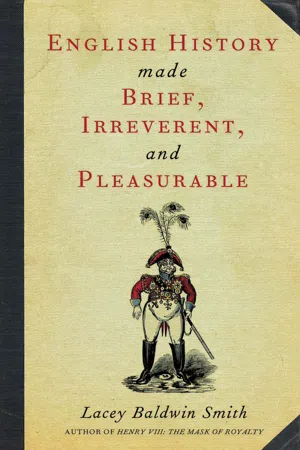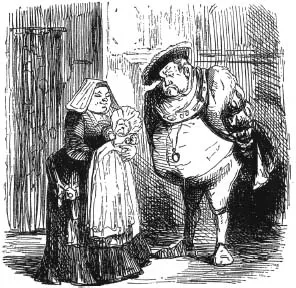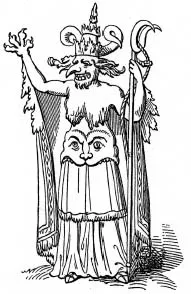![]()
Chapter IV
MORE MEMORABLE HISTORY, 1485 TO 1964
History used to be simpler, tidier, and far more optimistic than it is today. Nineteenth-century historians liked to credit Henry VII as the first of the so-called “New Monarchs.” His triumph over Richard III at the Battle of Bosworth Field was heralded as a good thing, for it inaugurated modern times and the end of the Middle Ages, those dreary centuries which came between the glories of Greece and Rome and the even greater glories of the modern age of capitalism, constitutionalism, professionalism, democracy and technology. Today’s historians dislike demarcating history in terms of battles and dynasties, or chopping up chronology into neat segments. They tend to see the first of the Tudors as just another medieval monarch, albeit a somewhat more efficient one, who profited from the memory of the civil wars of the roses and their political and human exhaustion, and they explain his success in reigning 24 years in terms of subterranean demographic, economic and social change which leave the reader depressed and confused.
Put in its simplest terms, somewhere around 1485, the English started to have more and better sex, and though there is no firm evidence that the poor became poorer, certainly the rich became richer. The population which had been reduced by a third, possibly even by a half, during the, second half of the 14th century, finally began to respond to the new economic impulses of the 1480s and ’90s, and began an unprecedented rate of growth, rising from two to four million by 1600. Those fortunate enough to survive the bubonic plague were economically better off than ever before: more food and land to go around, fatter and healthier babies, and higher wages for all. Landowners confronted with a labor shortage turned from labor-intensive agriculture to sheep farming, where a single hired hand could watch over an entire flock. Sheep runs and a European-wide demand for English wool and broadcloth produced unprecedented prosperity—“I thank God and ever shall; it is the sheep has paid for all.” Prosperity in turn began to undermine the old medieval regulation of trade and production that had sought to protect the consumer and establish, not a market or competitive price, but a just price for all. Finally, economic competition, inflation, and social mobility generated what society feared the most: change. New names, new blood, new methods were destroying the fabric of the medieval past. In the village of Apsley Guise, each peasant in 1275 had held equal holdings of 15 acres. By 1542, four lucky and hard-working families had increased their acreage to 60 acres or more; only three still possessed their original 15 acres; and all the rest had been forced to sell out, many of them migrating to London, the boom town of the Kingdom, where the population was quadrupling, rising from 50,000 in 1500 to 200,000 a century later.
Henry VII, The First of the Tudors (1485–1509)
The first of the Tudors may not have been a new monarch in the historical sense, but Henry VII was certainly the beneficiary of the new prosperity. It filled his royal coffers, and made him hard to unseat. Moreover, genealogically speaking, the seventh Henry contained a heavy dose of new and questionable blood (see the chart on p. 245). Like Henry IV and his heirs, he was descended from Edward III’s fourth son, John of Gaunt, Duke of Lancaster, and in 1485 he was the only viable Lancastrian claimant to the throne. Unfortunately, his royal blood came from the wrong side of the blanket, his great grandmother having been Gaunt’s mistress. Worse, their offspring, though legitimized, had been disbarred from the succession by act of Parliament. His paternal ancestry was equally questionable. His father was the product of the union of Catherine, the French widow of Henry V, and a lusty Welsh clerk of her wardrobe named Owen Tudor, but whether that son was born in or out of wedlock has never been established. Wisely, Henry claimed his throne primarily on the basis of God’s will, as revealed in battle.
Presumably on the advice of his lawyers (a legal education was rapidly becoming essential to anyone who wished to rise in politics), Henry, the day after he won his Crown, declared that his reign had commenced on the day before the Battle of Bosworth Field, thereby turning Richard’s supporters, who had loyally fought to save his throne, into traitors whose estates could be legally confiscated. Such dubious legal actions, plus his marriage to Edward IV’s eldest daughter, and a final pitched battle two years later against the remnants of the Yorkist forces, secured Henry his throne and bestowed upon him the legitimacy his tainted blood had left in dispute, but they did not earn him widespread public support. His subjects applauded his success in making his government solvent, but they found it difficult to love a sovereign who paid such close and unkingly attention to details, both financial and legal, “that no one dared to get the better of him through deceit or guile.” Henry’s excessive reliance on lawyers ran counter to medieval and chivalric tastes, and the first thing his son did when he mounted the throne as Henry VIII was to execute two of his father’s most efficient and unscrupulous lawyers, Empson and Dudley, anticipating by three generations Shakespeare’s famous suggestion that “the first thing we do, let’s kill all the lawyers.” It was the most popular act of the new reign!
Henry VIII and the Reconstruction of England (1509–1547)
At his death in 1509, Henry VII left a Crown more secure and wealthier and a Kingdom more prosperous than either had been for over a hundred years. How personally responsible he was for these blessings is debatable but, since they happened during his reign, he gets the credit for them. He also left a son of magnificent physique and unimpeachable legitimacy (he united in his veins the blood of both York and Lancaster) whose sexual appetite, conjoined with great difficulty in siring a legitimate male heir, plunged the Kingdom into a political and religious crisis that transformed England forever (see the chart on p. 246).
Henry’s tumultuous marital career and his unusual solution to his connubial problems—he divorced or executed four of his six wives—have excited the imagination for four and a half centuries. More important, his mixing of sex and politics when he determined to rid himself of his first wife, Catherine of Aragon, and marry Mistress Anne Boleyn, had dire and unexpected consequences. It swept away the ancient ecclesiastical structure with its head in Rome, opened up the Kingdom to Protestantism, and established the new nation state that demanded the undivided loyalty of all its citizens. On the surface, the problem in 1527 was simple. Henry at 36 was the father of a legitimate daughter, the Princess Mary, and an illegitimate son, Henry Fitzroy, Duke of Richmond; he was also husband to a Spanish wife five and half years his senior who could no longer bear him children. Equally important, he was in love with a vivacious young lady who refused to jump into his bed unless she became his queen. To do nothing not only deprived him of the pleasures Anne had to offer, but also left the Kingdom without a legitimate male heir and exposed the country to the dangers of civil war should Henry die, leaving the supporters of a legitimate daughter and a bastard son to fight over his Crown.
A Forgotten Deed of Valour: The King’s remembrancer tactfully reminding Henry VIII that His Majesty has already been married five times
What Henry needed was an annulment, and he called upon his good friend the Pope to oblige him on the grounds that his marriage to Catherine was illegal from the start, since she had been previously wedded to his deceased brother. Not even, he said, a papal dispensation could allow such a union so clearly prohibited by the Bible. Henry expected little trouble. He was such a staunch supporter of Rome that only five years before, His Holiness had awarded him the title of Defender of the Faith, a pretension to which English monarchs have tenaciously clung to this day. Unfortunately, Henry did not reckon with his wife’s family pride or the international balance of power. Catherine’s nephew was the Emperor Charles V, the most powerful sovereign in Europe, and the man who controlled the fate of Italy and therefore the decisions of the papacy. Pope Clement VII weaseled and squirmed and offered to marry the Princess Mary to her half-brother or legitimize any children Henry might have by Anne, but he would not annul his marriage to Catherine.
Henry showed extraordinary patience: his courtship of Anne and his negotiations with the papacy had been limping along for five years. But in the fall of 1532, the timetable of events speeded up dramatically. Anne finally broke down and by December she was pregnant, and on January 25, she and the King were secretly married. If Henry wanted to avoid bigamy and legitimize his offspring, he had less than seven months to act. To achieve his purpose, he cajoled Parliament into passing legislation that decreed the archepiscopal court of Canterbury to be the highest ecclesiastical court of the land from which no appeal was possible. This prevented any possibility of Catherine appealing her case to Rome, and in May, Archbishop Thomas Cranmer pronounced his King’s marriage to Catherine to be null and void. On the first of June, Anne was recognized as Queen, and on September seventh, much to the outrage of the father and the dismay of his astrologers, not to mention the glee of the Catholic world, the new heir turned out to be, not a son, but Elizabeth Tudor. With ironic ineptitude, the Pope finally got around to excommunicating the father on the day the child was born.
Henry had risked his soul and defied most of Christendom for yet another worthless daughter to further complicate the succession.
Henry VIII inspecting the Princess Elizabeth, another worthless daughter
The King, however, once committed, refused to back down, and in March of 1534, an obliging Parliament passed the momentous Act of Succession which severed forever the medieval duality of State and Church, body and soul. For the first time, a purely secular institution sat in judgment of divine law, and by act of Parliament Catherine’s marriage was “adjudged to be against the laws of Almighty God” and his marriage to his “most dear and entirely beloved Queen Anne” ordered to be “taken for undoubtful, true, sincere and perfect ever here-after.” The logical conclusion to the destruction of the old Church came in November when the Act of Supremacy declared Henry to be the “Supreme Head of the Church of England.”
A new polity was being shaped, in which diversity of mind or action was unthinkable, and the Act of Succession required all subjects to swear “without guile, fraud or other undue means” to “keep, maintain and defend this Act, and all the contents and effects thereof, and all other Acts … of this present Parliament.” The loyalty oath had been born. For the first time in Western European history, a government was reaching down into the souls of its citizens and requiring a new kind of conformity to the will of society. Anne’s marriage could no longer be accepted as fact. Now both approval of the wedding and the principles on which it rested were required: the break with Rome, the right of King and Parliament to speak for God, and Henry’s authority as Supreme Head of the English Church.
At this point Sir Thomas More, Henry’s ex-lord chancellor, author of Utopia, and England’s most distinguished humanist, drew the line; he refused to take the oath. He said he did “nobody harm,” thought “none harm,” wished “everybody good,” and “if this be not enough to keep a man alive, in good faith, I long not to live.” A year later he got his wish. He was executed on Tower Hill. As he mounted the scaffold, he cracked the most famous sick joke in history: “I pray you, I pray you, Mr. Lieutenant, see me safe up, and for my coming down let me shift for myself.” (Not far from his tomb in Chelsea Old Church on Cheyne Walk, there is a seated black-bronze statue of More with its hands, face, and medallion of office discordantly colored in gold.)
The man who directed Henry’s political and religious revolution was, of course, not the King, who was far too busy doing what early modern monarchs did best, fighting (mostly in France and Scotland) and going on progresses to display their royal persons to their subjects, but Thomas Cromwell, a blacksmith’s son who had led a feverish life soldiering in France, banking in Italy and practicing law in London before becoming Henry’s Vicar General in 1535. It was Cromwell who oversaw the destruction of the monasteries and the confiscation of lands worth £2 million—the largest nationalization of property until the French and Russian revolutions—which made Henry the wealthiest sovereign per capita in Europe.
Henry VIII plundering the monasteries
Cromwell also introduced the age of statistics and census-taking. He ordered every parish priest to keep a register of births, baptisms, marriages and deaths. What had once been a spiritual obligation on the part of the clergy, now had become a secular order mandated by the State which was awaking to the realization that statistical knowledge was power, especially the power to tax and control.
The price Henry had to pay to legalize his marriage was to ally himself with the religious reformers who really did think the Pope was the whore of Babylon. And though the King never himself became a Protestant, when Anne miscarried her second child—thereby conclusively proving that she had failed to live up to her marriage vows to be “bonaire and buxom in bed and at board”—he had her executed on trumped-up charges of adultery, and married a lady-in-waiting of the reformed faith. Jane Seymour survived the birth of her baby by only a few days, but she did supply her husband with the son for whom he had risked so much, and he had the young prince Edward educated by humanist teachers with strong Protestant leanings. As a consequence, his new Church fell prey to the religious inclinations of his three heirs: devoutly Protestant Edward, equally devoutly Catholic Mary, and Elizabeth, who wavered somewhere between the two extremes.
The Pope as the whore of Babylon
The Little Tudors (1547–1558)
Edward’s and Mary’s reigns are dreary evidence that good intentions are no guarantee of good results and as often as not end in disaster. At Henry’s death in 1547, his son Edward was nine, and the government fell to his maternal uncle Edward Seymour, the Lord Protector. Seymour was a genial and politically naive nobleman, who innocently thought that reason and goodwill were in and by themselves sufficient to achieve success in government. Unfortunately, he presided over a government composed largely of unscrupulous land-hungry colleagues and militantly puritanical religious reformers. The results were blatant corruption, open disobedience, political infighting, and religious turmoil, as every tavern, alehouse, street corner, and pulpit became a forum to debate the true nature of the mass. Was it a miraculous reenactment of Christ’s sacrifice on the cross in which the ceremonial bread and wine was literally transformed into the body and blood of the Savior as Catholics believed, or was it a commemorative service in which nothing changed except the hearts of the communicates as the Protestants maintained?
The Protector lasted only two years. In a palace coup engineered by John Dudley, Duke of Northumberland, he was arrested, deprived of office, and executed on fabricated charges of treason. Northumberland was closely allied with the Protestants (for political, not religious reasons since they advocated the sale of Church lands to the Duke and his cronies). And three years later, when it became apparent that Edward was fatally ill, Northumberland tried to save his political neck and prevent Catholic Mary following her brother on the throne, by arranging (with the dying Edward’s fervent blessings) the succession of Lady Jane Gray, who was Henry VIII’s grandniece, a devout Protestant and, best of all, the Duke’s daughter-in-law. Her reign of only nine days was clear evidence that Protestantism, especially in the hands of politicians, had won over few hearts, and that the overwhelming majority of the Kingdom preferred to stick to the succession as Henry had willed it: Edward, then Mary, and finally Elizabeth.
Mary’s reign was no more successful than her brother’s. She sought to turn the clock back to the golden days when her mother was undisputed Queen and her father a dutiful and faithful son of Rome. She longed to return her errant land to the Catholic fold and to marry her Hapsburg cousin Philip, the future King of Spain and the son of her mother’s stoutest champion, the Emperor Charles V (see the chart on p. 247). Mary achieved her ends, but they destroyed her reputation forever. Her marriage brought no heirs, only heartbreaks, and Philip at 28 is said to have remarked of his 38-year-old wife that “it would take God himself to drink of this cup.” The marriage also involved the Kingdom in yet another war with Fr...





